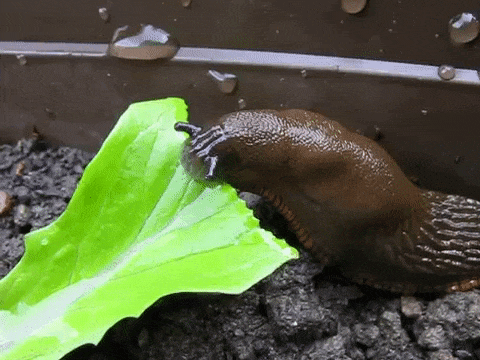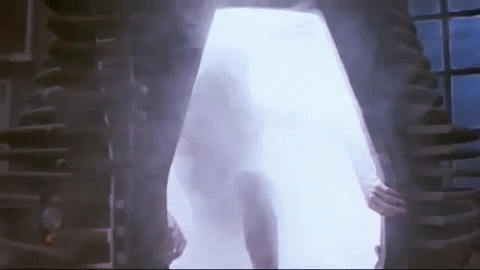Water Monsters and Body Horror, or Why You Shouldn't Eat Salad
My search for strange water beasts has taken an odd turn. I find myself searching through dozens of Netflix horror movies and asking myself weird questions:Is the monster eating that person’s head interesting enough to write about?Are suckers better than teeth? How might I describe that in a blog post?Would it be more effective if a tentacle shot out of its maw? Come on, tentacle, where are you?Aaaand that is where my quest for the most horrifying underrated water monster of all time died. I guess I was waiting for something nasty to poke it’s big ugly head above the water and say, “Wriiiite about meeee.”Then came spring break, and a much needed vacation on the Big Island of Hawaii.No, I didn’t meet a megashark or Kraken while swimming in Hawaii’s pristine waters. I found...slugs. Yes, slugs. I didn’t actually see them, mind you. I just heard about them. In the news. In the instructions for the rented jungle bungalow where we stayed. In my nightmares. Apparently, on the Big Island of Hawaii, slugs CAN KILL YOU.It’s actually the parasite on the slug and in its slime trails that does the grisly work, potentially paralyzing you for years with something called Rat Lung Disease. That thought kept me from eating salad for almost my entire stay. And I like salad.
Yes, slugs. I didn’t actually see them, mind you. I just heard about them. In the news. In the instructions for the rented jungle bungalow where we stayed. In my nightmares. Apparently, on the Big Island of Hawaii, slugs CAN KILL YOU.It’s actually the parasite on the slug and in its slime trails that does the grisly work, potentially paralyzing you for years with something called Rat Lung Disease. That thought kept me from eating salad for almost my entire stay. And I like salad. So, it makes one wonder, why aren’t there more slug monsters in movies? Leeches? Worms? They really deserve the monster spotlight, seeing that they CAN KILL YOU.This leads me to a special category of beast movie, a freakish subgenre called body horror.
So, it makes one wonder, why aren’t there more slug monsters in movies? Leeches? Worms? They really deserve the monster spotlight, seeing that they CAN KILL YOU.This leads me to a special category of beast movie, a freakish subgenre called body horror.  The greats include movies like The Fly, Alien, and Invasion of the Body Snatchers. Most audiences consider these stories far more intense than the jump scares and blood spatter of your average slasher flick or shark movie. Something changing you from the inside out—that’s truly horrifying.Enter the beast from the long-forgotten beast movie, Leviathan.The name carries a lot of history. Leviathan made its big entrance in the book of Job, and he's shown up in stories ever since as a big, bad, ugly sea monster that will swallow you whole. Leviathan is enormous. Big enough to eat a house.The 1989 movie of the same name decided to take a completely different route.
The greats include movies like The Fly, Alien, and Invasion of the Body Snatchers. Most audiences consider these stories far more intense than the jump scares and blood spatter of your average slasher flick or shark movie. Something changing you from the inside out—that’s truly horrifying.Enter the beast from the long-forgotten beast movie, Leviathan.The name carries a lot of history. Leviathan made its big entrance in the book of Job, and he's shown up in stories ever since as a big, bad, ugly sea monster that will swallow you whole. Leviathan is enormous. Big enough to eat a house.The 1989 movie of the same name decided to take a completely different route. Like I said. Slugs.Leviathan doesn't start out big. It starts out as some sort of parasite hanging out on a wrecked ship. Our heroes bring it back to their vessel, and it infects the crew. Then it escapes from a human host and starts to grow.I know what you're thinking. "Hey, that sounds like Alien!" And you'd be right. Ridley Scott's masterpiece came out a full ten years before Leviathan, and it's hard to overstate how much that film influenced the genre. Alien's dinner scene, which I will NOT create a GIF for, is one of the most terrifying pieces of body horror to ever splatter itself across the silver screen.But we have to give the makers of Leviathan a break, because they didn't merely copy Alien. They took something great and then tried to push the boundaries on the nasty scale, making the parasite idea more intense. Instead of nesting inside of a human host and then popping out, jack-in-the-box style, the Leviathan parasite changes you on a molecular level. Eventually, this monstrous amalgam of human and monster grows to biblical size and gives the audience a big ole scare.Even though the monster makers gave it their best, I'm not frightened by big leviathan. At all. But the dog-sized slug that comes out of the kitchen cabinet? Yeah, that's horrifying. And the microscopic creatures that started it all? Even worse.Next time you write a scary story, and your friends say "Think big!" I'll tell you something different. Think small. Those little parasites are everywhere, all the time. And nothing spikes the fear meter like a big dose of reality.
Like I said. Slugs.Leviathan doesn't start out big. It starts out as some sort of parasite hanging out on a wrecked ship. Our heroes bring it back to their vessel, and it infects the crew. Then it escapes from a human host and starts to grow.I know what you're thinking. "Hey, that sounds like Alien!" And you'd be right. Ridley Scott's masterpiece came out a full ten years before Leviathan, and it's hard to overstate how much that film influenced the genre. Alien's dinner scene, which I will NOT create a GIF for, is one of the most terrifying pieces of body horror to ever splatter itself across the silver screen.But we have to give the makers of Leviathan a break, because they didn't merely copy Alien. They took something great and then tried to push the boundaries on the nasty scale, making the parasite idea more intense. Instead of nesting inside of a human host and then popping out, jack-in-the-box style, the Leviathan parasite changes you on a molecular level. Eventually, this monstrous amalgam of human and monster grows to biblical size and gives the audience a big ole scare.Even though the monster makers gave it their best, I'm not frightened by big leviathan. At all. But the dog-sized slug that comes out of the kitchen cabinet? Yeah, that's horrifying. And the microscopic creatures that started it all? Even worse.Next time you write a scary story, and your friends say "Think big!" I'll tell you something different. Think small. Those little parasites are everywhere, all the time. And nothing spikes the fear meter like a big dose of reality. Enjoy your salad.
Enjoy your salad.